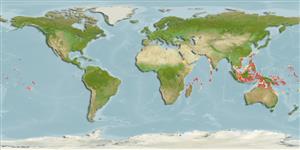Teleostei (teleosts) >
Gobiiformes (Gobies) >
Gobiidae (Gobies) > Gobiinae
Etymology: Priolepis: Greek, prio = to saw + Greek,lepis = scale (Ref. 45335); nocturna: Name from Latin nocturnus meaning 'of the night', presumed to refer to Smith's belief (1956:725) that this species lives a '.. Sheltered life in coral, almost certainly where the light is of low intensity.'; considered an adjectival form of nox and cannot be regarded as a noun (Ref. 9018).
More on author: Smith.
Environment: milieu / climate zone / depth range / distribution range
Ecology
Marine; reef-associated; non-migratory; depth range 8 - 30 m (Ref. 90102). Tropical
Indo-Pacific: Seychelles and the Maldive to the Marquesas, including the Philippines and Phoenix Is.
Size / Weight / Age
Maturity: Lm ? range ? - ? cm
Max length : 3.9 cm SL male/unsexed; (Ref. 9360)
Dorsal spines (total): 7; Dorsal soft rays (total): 10; Anal spines: 1; Anal soft rays: 8. This species is distinguished by the following characters: no fraenum; lateral line scale series 28 or more; pectoral fin rays 20 or more; nape and body with 4 broad dark bars on a light background; anterodorsal region of the caudal fin with an ocellated eye-sized dark spot (Ref. 9018); characterized further by having a pair of bands below eye; large partially ocellated black spots on both dorsal fins; ctenoid body scales to level of second dorsal spine, cycloid anteriorly, including base of pectoral fin, breast and ventrally on abdomen; head and median part of nape without scales; side of nape to above middle of opercle with small embedded scales; cheek without vertical row of papillae; depth of body 4.1 in SL (Ref. 90102).
Inhabits coral reef crevices in 8-30 m (Ref. 90102).
Life cycle and mating behavior
Maturity | Reproduction | Spawning | Eggs | Fecundity | Larvae
Randall, J.E. and M. Goren, 1993. A review of the gobioid fishes of the Maldives. Ichthyol. Bull. J.L.B. Smith Inst. Ichthyol. (58):1-37, 5 pls. (Ref. 9360)
IUCN Red List Status (Ref. 130435: Version 2024-1)
Threat to humans
Harmless
Human uses
Tools
Special reports
Download XML
Internet sources
Estimates based on models
Preferred temperature (Ref.
123201): 26.2 - 28.9, mean 27.7 °C (based on 176 cells).
Phylogenetic diversity index (Ref.
82804): PD
50 = 0.5000 [Uniqueness, from 0.5 = low to 2.0 = high].
Bayesian length-weight: a=0.01023 (0.00477 - 0.02194), b=3.01 (2.83 - 3.19), in cm total length, based on LWR estimates for this (Sub)family-body shape (Ref.
93245).
Trophic level (Ref.
69278): 3.2 ±0.3 se; based on size and trophs of closest relatives
Resilience (Ref.
120179): High, minimum population doubling time less than 15 months (Preliminary K or Fecundity.).
Fishing Vulnerability (Ref.
59153): Low vulnerability (10 of 100).
